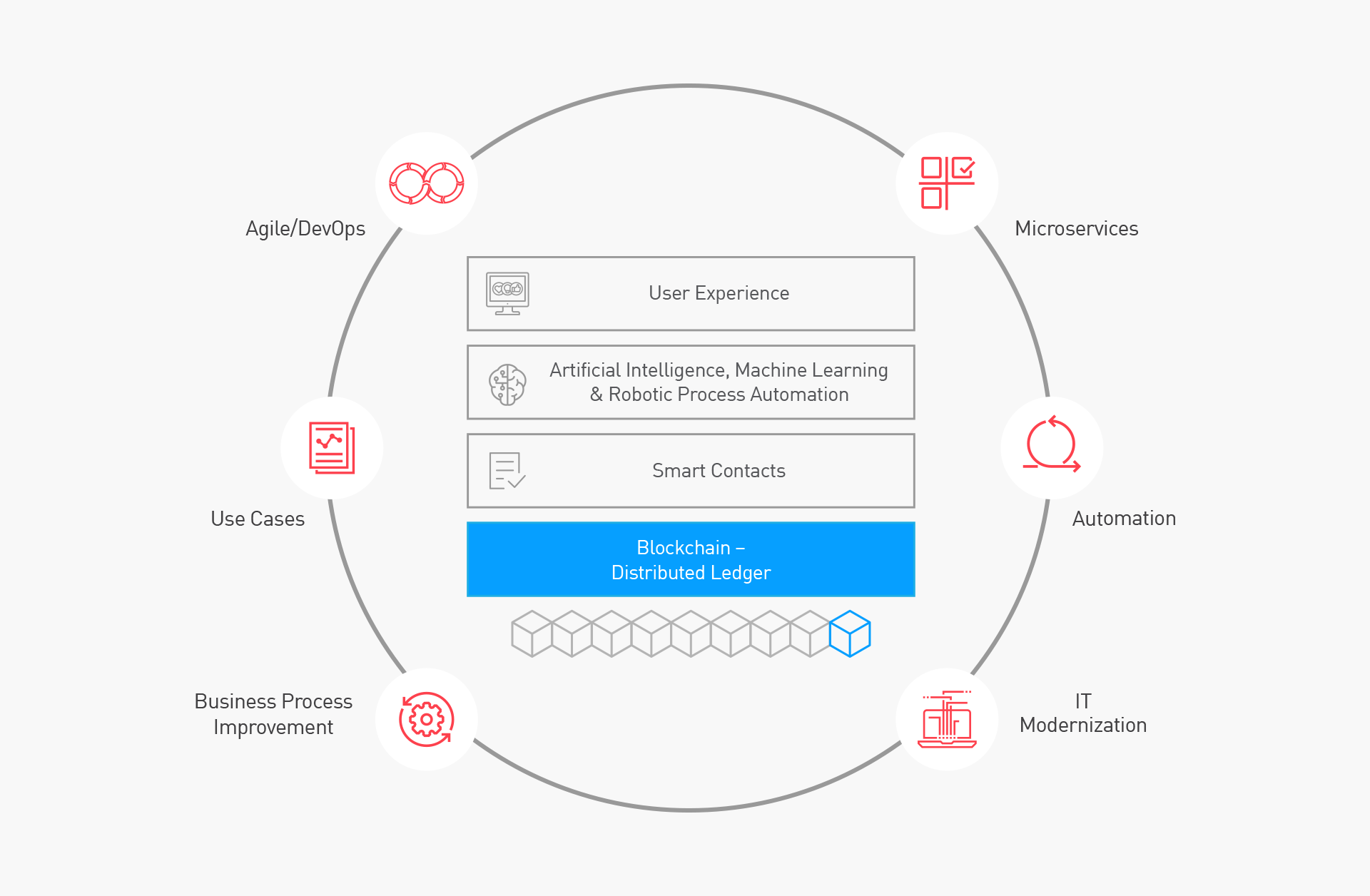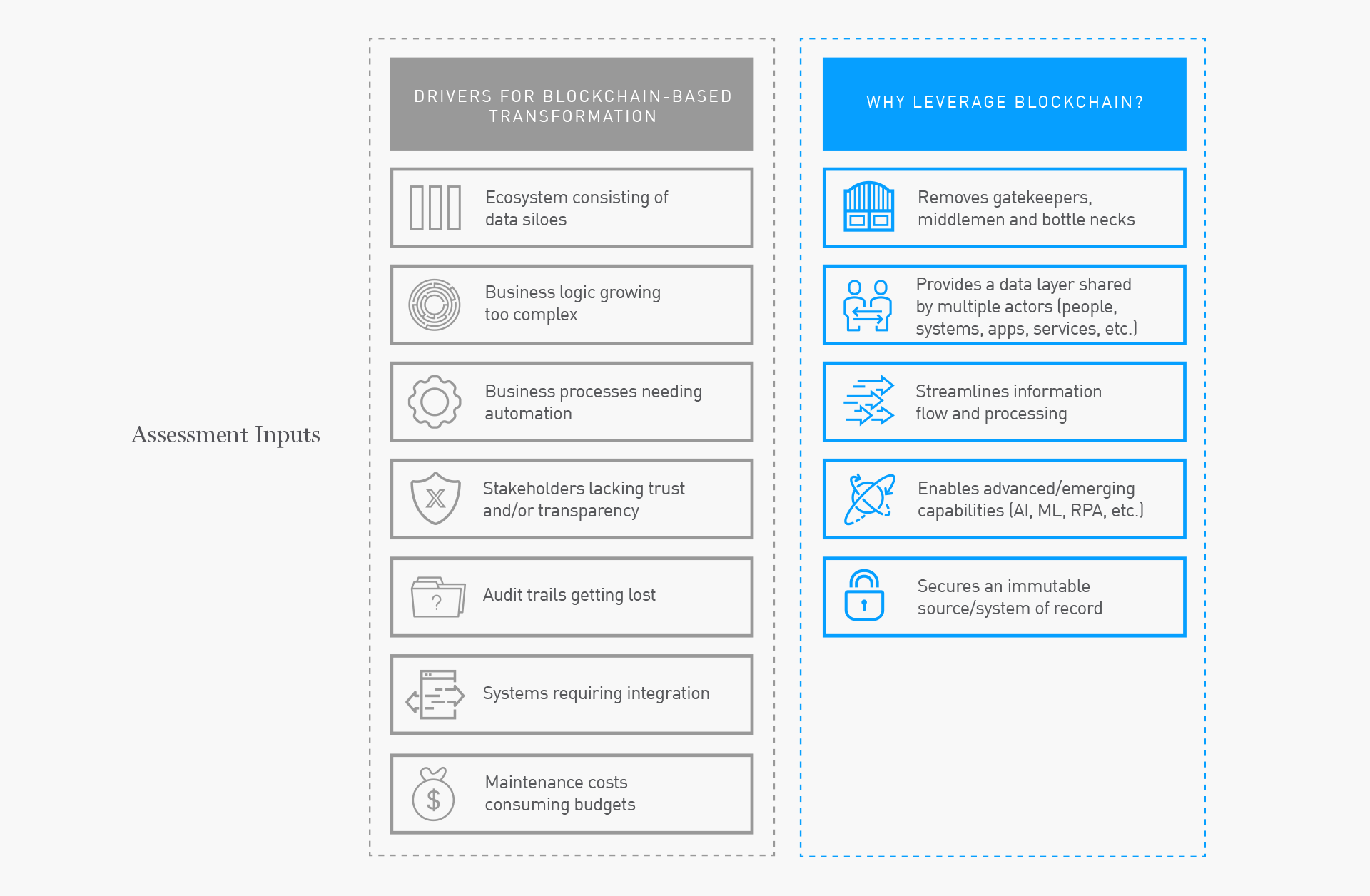In exploring potential blockchain applications, it’s helpful to consider the many multi-dimensional use cases already uncovered. Current government use cases primarily focus on two key areas:
- Increasing Operational Efficiency – such as identity management, benefits management, contracting and procurement, asset tracking, trade and regulatory compliance
- Improving Citizen Services – such as constituent engagement, voting, taxation, permitting, entitlements and aid, healthcare and disaster recovery
Increasing operational efficiency
Performance and deliverable-based smart payment
Using service level agreements (SLAs) between government agencies and contracted service providers is a common practice for validating contractual terms for performance and/or determining whether or not completion milestones are met prior to payment. To streamline the process, the government could transpose SLA, performance/delivery requirements, and applicable dates directly into smart contracts that would execute on the specified date and ensure payment is released in proportion to the contractual terms fulfilled. The blockchain could then be extended to automatically share the performance data captured with other agencies considering contracts with the same service providers.
Smart procurement
Accounting for roughly $500 billion annually, procurement by the United States federal government is highly regulated, fragmented and paper-based. A decentralized, standardized and blockchain-based procurement ecosystem could greatly reduce disjointed systems and processes while providing agencies with transparency and flexibility to make smarter purchasing decisions. For example, blockchain could consolidate commodity purchase contracts such as printers, paper or phones to transparently deliver increased purchasing power and a more even playing field for vendor selection.
Artificial intelligence (AI)
Agencies can further improve decision-making by supplementing blockchain with an AI engine. For example, if purchasing paper in bulk, the AI engine could offer recommendations and draw conclusions to support decisions such as the cost effectiveness of buying paper from distributors versus printers.
International trade transparency
For international trade, government agencies interact with multiple lenders, suppliers and customs agencies. There are also several third parties involved over which the agency has no control. Oftentimes, trust among the many parties is lacking or difficult to maintain. With blockchain, agencies could connect and transact with intermediaries and third parties in an open format, resolving bottlenecks and transparency concerns.
Smart asset tracking
Government agencies track tens of thousands of assets. For example, an agency might have more than 10,000 federally owned vehicles in use. With smart asset tracking, coupled with the internet of things (IoT), the agency could track the vehicles with blockchain in real time, capturing transactions and enabling more efficient auditing, monitoring and planning.
Audit automation
When a government or regulatory agency performs an audit, several other agency, local, independent and bank auditors get involved. Throughout the process, these parties must inform each other of what stage the audit is in, what the findings are, when to sign off, and so on. A distributed ledger can drastically simplify this process by tracking the status and automatically alerting parties at precisely the right time via smart contracts. Additionally, the distributed ledger provides one place for auditors to read and react to information. It creates an audit trail that does not require hundreds of people to verify the information.
Robotic process automation (RPA)
To expand upon automation enabled by the distributed ledger and smart contracts, agencies can leverage RPA to further eradicate repetitive tasks throughout the workflow. For example, if upon receiving an alert via smart contracts that a party needs to extract key information and enter it into an internal application for further processing, an RPA tool can be used to seamlessly transfer the information in an efficient and consistent manner.
Personnel management
When people become federal employees, records are created and tracked throughout their careers, which include information such as years of service, where they worked, salary history, performance appraisals, and much more. With many disparate systems in place, the process has become complex with information spread across multiple systems, offering little or no transparency. Blockchain can connect the many agency tracking systems to cryptographically secure the sensitive personnel data and ensure it is accessible only by those with appropriate permission. Furthermore, by leveraging machine learning in combination with smart contracts, the information can be cleaned, validated and standardized.
Machine learning
When information such as a date, phone number or address is incorrectly formatted, a machine learning service can recognize the error, enabling a smart contract to then properly update and make the information available when it would have otherwise been lost or unavailable.
Improving citizen services
Digital identity management
When considering the many elements of an individual’s identity–from name, age and address to employer, credit score and family members–it is easy to understand the importance of allowing individuals to have complete control over which elements are shared, who they’re shared with and for how long. The government plays several roles in managing a citizen’s identity, from issuing and maintaining, to validating and serving as the source of authoritative truth. The government processes and systems that maintain and secure the information are highly fragmented and costly. In addition, citizens bear the risk and potentially enormous consequences of data mismanagement. By using a distributed ledger to provide a highly secure, self-sovereign digital identity for each citizen, the government’s maintenance burden would be greatly alleviated, enabling greater trust and control by citizens. With identity elements maintained by citizens and then validated through consensus, government could leverage blockchain as a source of truth for tendering and tracking additional citizen services.
Smart health records and surveillance
In its role of protecting the health and well-being of citizens, the government requires access to massive amounts of sensitive health data to monitor for and proactively prevent disease outbreaks. With the cooperation of health systems to securely connect health information exchanges to a distributed ledger, the government could be given access to de-identified health records while leveraging smart contracts for near real-time alerts to reported diagnoses.
Smart voting
Across the country, processes and technologies used to accurately conduct voting vary widely. Voter fraud, vote count accuracy and cybersecurity compromises are major concerns. In combination with blockchain-based identity management, voting can be digitized and executed on a distributed ledger using smart contracts. All citizens could be automatically validated as eligible to vote and issued a “token” for each vote they are allowed to cast, eliminating instances of double-counting or voter fraud while also providing a fully transparent and verifiable audit trail of votes.
Aid and entitlements
Nearly 50 percent of U.S. citizens receive assistance from the government in the form of financial aid, healthcare benefits or other entitlement and welfare programs. Many systems and processes for managing the benefits programs are severely outdated and rife with fraud and abuse. Additionally, given the lack of interoperability with other government systems and the difficulty securing data, many citizens rightfully deserving of aid are delayed from receiving it. Again, in combination with identity management and stringing together data sources from across the government onto a blockchain solution, smart contracts can be used to automatically qualify and register citizens to receive the aid they need. Ongoing tracking and monitoring of the program could also be automated to prevent fraud and overpayment.












